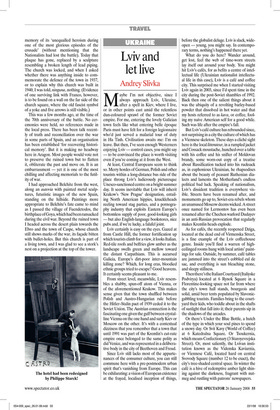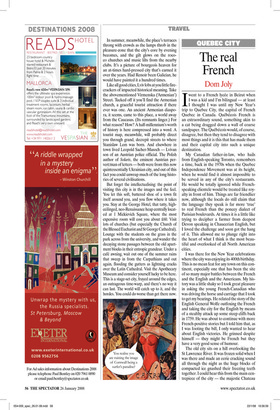Lviv and let live
Andrey Slivka
Maybe I’m not objective, since I always approach Lviv, Ukraine, after a spell in Kiev, where I live, or in other points east amid the relentless dun-coloured sprawl of the former Soviet empire. For me, entering the lovely Galician town feels like what entering belle époque Paris must have felt for a foreign legionnaire who’d just served a malarial tour of duty in Ha Tinh. Civilisation awaits me: I’m on leave. But then, I’ve seen enough Westerners enjoying Lviv — control cases, you might say — to be convinced the place is worth visiting even if you’re coming at it from the West.
At least, Central Europeans seem to think so. Merry hordes of German, Polish and other tourists within a long-distance bus ride of the place throng Lviv’s ludicrously picturesque Unesco-sanctioned centre on a bright summer day. It seems inevitable that Lviv will inherit Krakow’s ‘New Prague’ designation, entailing North American hippies, knuckleheads reeling toward stag parties, and a pornography industry that exploits Eastern Europe’s bottomless supply of poor, good-looking girls — but also English-language bookstores, nice pubs and, if we’re lucky, a falafel joint.
Lviv certainly is easy on the eyes. Gazed at from Castle Hill, the former fortification up which tourists climb for a view, it looks Italian. Red-tile roofs and belfries glow amber as the landscape swells green and mellow toward the distant Carpathians. This is accursed Galicia, Europe’s dirt-poor inter-mountain killing zone? Which, for long eras, bloodied ethnic groups tried to escape? Good heavens. It certainly seems pleasant to me.
From street level, meanwhile, Lviv resembles a shabby, spun-off atom of Vienna, or of the aforementioned Krakow. This makes sense given that the town shuffled between Polish and Austro-Hungarian rule before the Hitler–Stalin pact of 1939 ceded it to the Soviet Union. The Austrian connection is the fascinating one given the gulf between crystalline Vienna on the one hand and surly Kiev or Moscow on the other. It’s with a contextual dizziness that you remember that a town that until 1991 was part of the Kremlin’s cut-rate empire once belonged to the same polity as did Venice, and was represented in a deliberative body in the city of Beethoven and Freud.
Since Lviv still lacks most of the appurtenances of the consumer culture, you can still commune here with a pre-postmodern urban spirit that’s vanishing from Europe. This can be exhilarating: a vision of European existence at the frayed, localised inception of things, before the globalist deluge. Lviv is slack, wideopen — young, you might say. In contemporary terms, nothing’s happened there yet.
What do you do here? Wander around, get lost, feel the web of time-worn streets lay itself out around your body. You might hit Lviv’s cafés, for as befits a centre of intellectual life (Ukrainian nationalist intellectual life in this case), Lviv is a café and coffee city. This surprised me when I started visiting Lviv again in 2003, since I’d spent time in the city during the post-Soviet shambles of 1992. Back then one of the salient things about it was the ubiquity of a revolting barley-based powder that dissolved in hot water and that my hosts referred to as kava, or coffee, fooling my naive American self for a good while. Such was life after the empire’s fall.
But Lviv’s café culture has rebounded since, not surprising in a city the culture of which has a Viennese skeleton. These days a cliché sight here is the local litterateur, in a rumpled jacket and Cossack moustache, hunched over a table with his coffee and his snifter of Moldovan brandy, some worn-out copy of a treatise about Russification tucked into his rucksack as, in euphonious Ukrainian, he rhapsodises about the beauty of peasant Ruthenian dialects and laments the Motherland’s endless political bad luck. Speaking of nationalism, Lviv’s dissident tradition is everywhere visible. Streets have been renamed after, and monuments go up to, Soviet-era rebels whom an unamused Moscow deems wicked. A street once named for Lermontov has even been renamed after the Chechen warlord Dudayev in an anti-Russian provocation that regularly makes Kremlin heads explode.
As for cafés, the recently reopened Dziga, located at the dead end of Virmenska Street, is a fine example of the Lviv coffeehouse genre. Inside you’ll find a warren of highceilinged rooms hung with local artists’ paintings for sale. Outside, by summer, café tables are jammed into the street’s cobbled cul de sac, and everything is sun bleaching stone, and sleepy stillness.
Then there’s the Italian Courtyard (Italiyske Podvirya) located at 6 Rynok Square in a Florentine-looking space not far from where the city’s town hall stands, bourgeois and solid, amid beer tents populated by Slavonicgabbling tourists. Families bring to the courtyard their kids, who toddle about in the shafts of sunlight that fall into it; their parents sip in the shadows of the arcades.
Or there’s Under the Blue Bottle, a hutch of the type in which your soul pines to spend a snowy day. Or Svit Kavy (World of Coffee) at 6 Katedralna Square. Or Tsoukernia, which means Confectionary (3 Staroyevrejska Street). Or, most saliently, the Lvivan institution known as the Videnska Kaviarnia, or Viennese Café, located hard on central Svovody Square (number 12 to be exact), the city’s tree-shaded central space. In winter the café is a hive of redemptive amber light shining against the darkness, fragrant with nutmeg and rustling with patrons’ newspapers. In summer, meanwhile, the place’s terraces throng with crowds as the lamps throb in the pleasure-zone that the city’s core by evening becomes, and the gilt glows on the rococo churches and music lilts from the nearby clubs. It’s a picture of bourgeois heaven for an at-times hard-pressed city that’s earned it over the years. Had Renoir been Galician, he would have painted it a hundred times.
Like all good cities, Lviv lobs at you little firecrackers of impacted historical meaning. Take the abovementioned Virmenska (‘Armenian’) Street. Tucked off it you’ll find the Armenian church, a graceful tourist attraction if there ever was one. An ancient Armenian diaspora, it seems, came to this place, a world away from the Caucasus. (Its remnants linger.) For what reason? How? A half-millennium’s worth of history is here compressed into a word. A tourist map, meanwhile, will probably direct you through grand, decrepit streets to where Stanislaw Lem was born. And elsewhere in town lived Leopold Sacher-Masoch — Lvivan son of an Austrian police official. The Polish author of Solaris, the eminent Austrian pervert/man of letters — both were from this now quintessentially Ukrainian city, and out of this fact you could unwrap much of the long histories of several civilisations.
But forget the intellectualising: the point of visiting this city is in the images and the feel. You let this soft, battered shoe of a town fit itself around you, and you flow where it takes you. Stay at the George Hotel, that tatty, highceilinged, neo-Renaissance heap centrally located at 1 Mickievich Square, where the most expensive room will cost you about £60. Visit lots of churches (but especially the Church of the Blessed Eucharist and St George Cathedral). Lounge with the students on the grass in the park across from the university, and wander the decaying stone passages between the old apartment blocks in their entropic grandeur. Under a café awning, wait out one of the summer rains that sweep in from the Carpathians and out again, flooding the gutters as lightning cracks over the Latin Cathedral. Visit the Apothecary Museum and consider yourself lucky to be here. This is a stage-set city, frayed around the edges, an outrageous time-warp, and there’s no way it can last. The world will catch up to it, and the hordes. You could do worse than get there now.











































































 Previous page
Previous page